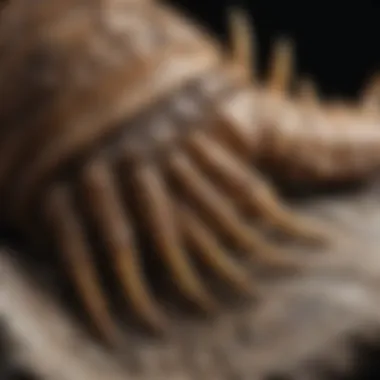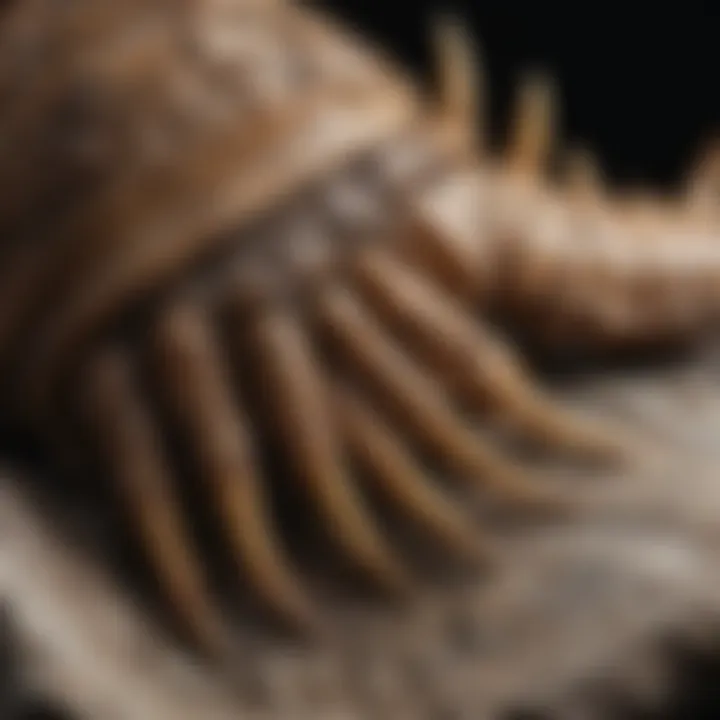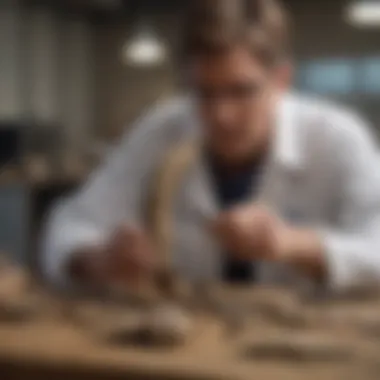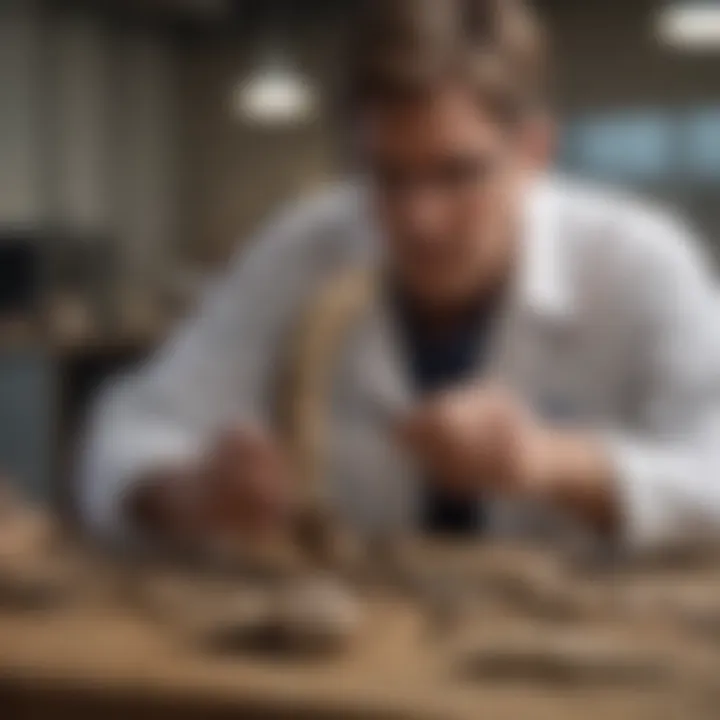The Fascination with Fossilized Raptor Claws


Intro
Fossilized raptor claws have captivated paleontologists, collectors, and enthusiasts alike. These remnants from a bygone era offer much more than mere aesthetic value. They are crucial for understanding the behavior, habitat, and evolution of ancient raptors. This article examines the significance of these fossils, focusing on their scientific, historical, and cultural importance. By the end, readers will gain valuable insights into identification techniques and preservation methods that enhance the appreciation for raptor fossils within the fossil-collecting community.
Featured Collectible of the Month
Overview
This month, we highlight fossilized raptor claws from the Velociraptor genus. Famous for its depiction in popular culture, Velociraptor has intrigued both scientists and the public. The claws of this dinosaur are distinct, often characterized by their curved and elongated shape, ideal for predatory activities. Collectors and enthusiasts recognize Velociraptor claws as exceptional pieces of paleontological history that embody both beauty and scientific value.
Historical Significance
Raptors, particularly the Velociraptor, are well-documented from the Late Cretaceous period, approximately 75 to 71 million years ago. Fossilized raptor claws provide insights into the ecology of their time; these claws illustrate the predator-prey dynamics that existed millions of years ago. The discovery of Velociraptor fossils in Mongolia has been pivotal, shedding light on the diversity and adaptability of these theropods. Such findings enhance our understanding of evolutionary processes and help reconstruct the ancient ecosystems in which these creatures thrived.
Identification Techniques
Visual Characteristics
Identifying fossilized raptor claws requires an keen eye. Here are important features to consider:
- Size: Raptor claws tend to range in size, but the Velociraptor claws typically measure about 2 to 3 inches in length.
- Shape: Look for curved and narrow claws. The inner edge is more sharply pointed, ideal for tearing flesh.
- Texture: Examine the fossil for unique textures. Raptor claws often display fine details, such as grooves or ridges, that suggest their function.
- Color: Fossils may vary in color based on mineralization. Common hues include browns and grays, but they can be more vibrant in well-preserved specimens.
Resources for Identification
For collectors seeking more information on identifying raptor claws, the following resources can be invaluable:
- Wikipedia
- Britannica
- Facebook Groups focusing on fossil collecting
As collectors dive into the fascinating world of fossilized raptor claws, understanding these identification techniques is essential. Through detailed examination and research, enthusiasts can appreciate the richness of these ancient fossils. Understanding their scientific and historical contexts not only enhances their value but also deepens the connection between collectors and these significant remnants of life from millions of years ago.
Preamble to Fossilized Raptor Claws
Fossilized raptor claws capture a unique intersection of paleontology, evolutionary biology, and collecting culture. Examining these fossils unveils insights about the behaviors and adaptive strategies of ancient raptors. They are not just objects of curiosity; rather, they serve as valuable data points in understanding the past ecosystems. For rock and fossil collectors, these claws symbolize a tangible connection to prehistoric life, offering an opportunity to own a piece of history.
Understanding Fossils
Fossils are remnants or traces of ancient life, preserved in the geological record. The process of fossilization allows scientists to study organisms long after they have disappeared from the face of the Earth. Fossils can be bones, shells, or even impressions left by living creatures, which highlight biological and ecological dynamics of specific time periods. Fossilized raptor claws not only provide evidence of the physical characteristics of these creatures but also reveal their environmental adaptations and hunting strategies. Recognizing the process of fossilization is crucial for understanding how these ancient life forms interacted with their surroundings and evolved over millions of years.
Raptors: An Overview
Raptors, or birds of prey, are a group of carnivorous mammals that existed during the Mesozoic era, specifically in the Late Cretaceous period. Notable for their sophisticated predatory behaviors, raptors like Velociraptor and Deinonychus were among the most feared carnivores, embodying agility and sharp hunting instincts. Their claws were not only tools for grasping prey but also played roles in territory defense. Understanding the characteristics of these raptors informs collectors about the ecological context in which these claws functioned, enriching the narrative associated with each fossil.
Raptors are often associated with dynamic predation techniques, suggesting they were capable of complex behaviors. Thus, the study of fossilized raptor claws extends beyond mere anatomy; it encapsulates a broader understanding of their role in prehistoric ecosystems.
Significance of Raptor Claws in Paleontology
The fossilized claws of raptors hold immense significance within the realm of paleontology. These remnants offer not only a glimpse into the lives of these ancient creatures but also provide vital information pertaining to their evolution, behavior, and ecological roles. By studying raptor claws, scientists can reconstruct aspects of their predation strategies, habitat preferences, and interactions with other species. This knowledge enriches our understanding of the ecosystems that prevailed during the age of dinosaurs.
Furthermore, the claws serve as tangible links to the past, embodying the complexities of evolutionary transitions. Understanding the significance of raptor claws lies in both their scientific value and their appeal to collectors and enthusiasts.
Evolutionary Insights
Fossilized raptor claws contain crucial evolutionary insights. The morphology of these claws can reveal adaptations to specific environments and modes of predation. For instance, larger and more curved claws may indicate a predilection for catching slippery prey, while straighter claws could suggest different hunting techniques or ecological niches. By analyzing variations in claw structure across various raptor species, paleontologists can draw conclusions about their evolutionary lineage and how certain traits may have developed over time.
Additionally, the study of raptor claws contributes to the broader discussion of how dinosaurs adapted to their environments. These adaptations can inform researchers about climate changes, migrations, and extinctions. They help create a narrative about survival and specialization that spans millions of years.
Claw Morphology and Function


Claw morphology is more than a subject of aesthetic appreciation; it serves practical functions that are essential for understanding raptor behavior. The shape, size, and sharpness of claws are critical for their evolutionary success. Raptors, known for their predatory capabilities, utilized their claws for capturing prey, climbing, and possibly even courtship displays.
For example, the claws of Velociraptor are often depicted as long and curved, which would have aided in grasping and holding onto struggling prey. In contrast, some modern birds descended from theropods exhibit various adaptations in their claws according to their ecological niches, thus demonstrating a lineage of functional claw morphology from the past to the present.
Researchers can classify raptor claws into different types, considering factors such as:
- Curvature: Indicates hunting strategies.
- Length: Suggests prey size.
- Tapering: Reflects grip strength and agility.
Understanding these characteristics enhances our comprehension of how raptors fulfilled their ecological roles. Given these details, the significance of raptor claws extends beyond mere curiosity and offers profound insights into both paleontological science and the intricate tapestry of life.
Historical Context of Raptor Fossils
Understanding the historical context of raptor fossils is crucial for comprehending their significance in paleontology. Raptor claws have been the subject of fascination not only for scientists but also for collectors. This context reveals how discoveries over time have shaped our current understanding of these remarkable creatures. Examining the history of raptor fossils provides insights into both the methodology of paleontological research and the evolution of public interest in dinosaurs.
Key Discoveries
The journey of raptor fossil discovery is marked by a series of pivotal finds that pushed the boundaries of our knowledge. One of the earliest notable discoveries was the Velociraptor mongoliensis, first described in the 1920s from fossils found in Mongolia. This find opened up a new understanding of small, agile predators. Scientists noted the distinct features of Velociraptor claws, which appeared more adapted for grasping than slashing, indicating a potential predatory behavior that was more complex than previously thought.
Other significant discoveries include Deinonychus and Utahraptor. These species contributed to a broader understanding of raptor physiology and behavior. The identification of these organisms helped construct the idea that these creatures were not solitary hunters. Instead, they likely hunted in packs, which was suggested by the structure of their claws and teeth. This evolving narrative continues to influence modern paleontological studies.
Important Fossil Sites
The significance of raptor fossils is heavily tied to their geographic origins. Key fossil sites around the world have yielded essential specimens that have contributed to the field of paleontology.
- Gobi Desert in Mongolia: This is perhaps the most famous raptor fossil site. The harsh conditions have preserved many remarkable raptor specimens. Experts continue to go there for research purposes.
- Fossil Butte National Monument in Wyoming: Known for a diversity of well-preserved fossils, this site has yielded findings that include raptor claws alongside other prehistoric creatures.
- Two Medicine Formation in Montana: This site houses important raptor fossils and provides crucial data about the ecology of the Late Cretaceous period. Each of these locations plays a vital role in understanding the variation and adaptation of raptors in different environments.
"The history of raptor research is not just a record of what was found, but a reflection of the evolving scientific inquiry into dinosaur life."
Through ongoing research and explorations, our comprehension of raptor claws will continue to expand, revealing more about the lives they once led.
Collecting Fossilized Raptor Claws
Collecting fossilized raptor claws serves multiple purposes beyond mere curiosity. This activity allows enthusiasts to connect with ancient life and contributes to the understanding of paleontological history. While pursuing this fascinating hobby, collectors can play a role in the preservation of information about raptors. Not only does collecting offer personal satisfaction, but it also gives a chance to participate in a wider community of fossil enthusiasts.
Legal and Ethical Considerations
Engaging in the collection of fossilized raptor claws often raises legal and ethical questions. Laws vary significantly across regions and countries. It is important for collectors to understand local regulations, including what can be taken from natural sites. Often, certain fossils may be deemed protected, requiring permits to collect. Not adhering to these rules can lead to significant fines or even legal action.
Furthermore, ethical considerations extend to the impact on educational sites and public land. Removing fossils from scientific locations may hinder future research or teaching opportunities. Collectors should always prioritize environmentally responsible practices. Sharing collected data with paleontological societies can also enhance the collective knowledge within the field.
"The integrity of paleontological research depends on ethical collecting practices."
Tips for Beginners
For those just starting in the world of fossilized raptor claw collecting, a few practical tips can help ensure a rewarding experience. First, familiarize yourself with identification tools. Books, as well as digital resources like Wikipedia and Britannica, can be invaluable in providing a base knowledge. Here are some more tips:
- Join a local fossil club: This provides opportunities to learn from experienced collectors and participate in community digs.
- Attend workshops: Many organizations offer training on safe and effective collection methods. Knowledge gained here can avoid mistakes that new collectors often make.
- Start small: Focus on small fossils at first before moving on to rarer pieces. This approach builds confidence and knowledge.
- Network online: Explore platforms like Reddit and specialized forums on Facebook. These communities often discuss tips and tricks that can be critical for beginners.
By ensuring understanding and respect for the fossilized raptor claw community, newcomers can find joy in this exciting venture.
Identification of Raptor Claws
Identifying fossilized raptor claws is a critical aspect in the study and appreciation of these ancient remnants. Proper identification goes beyond mere recognition; it can yield significant insights into the raptor's physical characteristics, ecological role, and even behavior patterns. This knowledge aids paleontologists, collectors, and enthusiasts alike in placing fossil finds within their correct historical and scientific context.
Distinguishing Features
When attempting to identify raptor claws, several key distinguishing features can be quite telling. The first feature to observe is the size of the claw. Different species of raptors have varying sizes, thus allowing collectors to narrow down the potential identification. Furthermore, the shape of the claw is also paramount. Raptors generally possess curved claws, which assist in grasping prey.
Another distinguishing characteristic is the texture of the fossil. Raptor claws can show different surface patterns, indicative of their type. Observing subtle details on the claw can provide information about the raptor's diet and hunting methods. The coloration can also be a guide; depending on the fossilization process, colors may vary but often reflect the mineral composition of the surrounding sediment.


To summarize, when identifying raptor claws, consider the following features:
- Size of the claw
- Shape and curvature
- Surface texture
- Coloration
Resources for Identification
For those interested in identifying raptor claws, a variety of resources exist. Books on paleontology often contain sections specifically for the identification of dinosaur fossils. Some highly recommended texts include:
- "Dinosaurs: A Global View" by David Norman
- "The Dinosauria" edited by David B. Weishampel et al.
Online resources can also be invaluable. Websites like Wikipedia and Britannica host articles that delve into raptors and their fossils. They provide comprehensive overviews that can aid in identification.
Engaging with communities on platforms like Reddit can also facilitate knowledge exchange, where seasoned collectors share experiences and insights. Collectors' groups, both online and in-person, often organize workshops dedicated to identification techniques.
Ultimately, having access to various resources enhances one's ability to accurately identify raptor claws, fostering a deeper appreciation for these fascinating relics.
Preservation Techniques
Preserving fossilized raptor claws is vital for maintaining their integrity and value. The methods employed in preservation not only enhance the visual appeal of these fossils but also ensure that the scientific data contained within them remains intact for future research. Proper preservation techniques can provide collectors with a sense of pride knowing that their fossils are well cared for, while also making them accessible to paleontologists and researchers.
Best Practices for Storage
When storing fossilized raptor claws, it is essential to create an environment that minimizes physical damage and chemical degradation.
- Cool, Dry Locations: Store fossils in a climate-controlled environment. Excessive heat and humidity can lead to deterioration.
- Use Acid-Free Materials: Utilize acid-free boxes and materials. Acidic conditions can harm the fossils over time, causing discoloration and structural damage.
- Avoid Direct Sunlight: Exposure to direct sunlight can fade colors and weaken fossil structures.
- Supportive Storage: Instead of stacking fossils, use padded containers that provide support. This helps reduce stress on delicate structures and prevents breakage.
- Monitor Regularly: Check regularly for signs of mold or pest infestation. An early response can save the claw from extensive damage or even destruction.
Using these methods ensures the long-lasting preservation of fossilized raptor claws, protecting both their educational and monetary value.
Restoration Methods
Restoration of fossilized raptor claws can be a delicate process. While it is sometimes necessary to restore fossils to retain their beauty or structural integrity, it requires a careful approach to maintain authenticity.
- Cleaning Techniques: When cleaning fossils, avoid harsh chemicals. Soaking the claw in warm, soapy water can remove dirt without inflicting damage.
- Epoxy Resins for Repairs: If a claw has broken, using epoxy resin can help reassemble it. Choose a high-quality, clear epoxy that will preserve visibility.
- Preserving Original Form: Always prioritize the preservation of the original structure. Avoid excessive reshaping or altering of the claw, as this detracts from its authenticity.
- Consulting Experts: If unsure about restoration methods, consulting with paleontologists ensures fossils are treated with the care they deserve. They can provide guidance based on specific types and conditions of the fossils.
Proper preservation and restoration of fossilized raptor claws are essential not just for collecting, but for future scientific study as well.
Using these techniques, collectors can maintain their fossils effectively. By doing so, they contribute not only to their personal collection but also to the broader understanding of paleontological history.
Cultural Impact of Raptor Claws
The fascination with raptor claws extends beyond the scientific community and into culture. This impact reveals how these ancient fossils shape narratives in various forms of expression, from media portrayals to mythological contexts. Understanding this cultural significance enhances appreciation and offers insights into human perspectives on ancient life.
Representation in Media
Raptor claws have made notable appearances in films, documentaries, and various forms of artwork. Their fierce appearance often symbolizes danger and power. Movies like "Jurassic Park" popularized raptors, including their claws as a key feature. This representation has led to a broader interest in paleontology and dinosaurs in general.
The claws evoke awe and curiosity, often appealing to the public's imagination regarding prehistoric creatures. Documentaries on cable channels like National Geographic delve into the life of these raptors, discussing their hunting behaviors and environmental adaptations. These visual presentations often fuel the imagination and encourage discussions around the characteristics of these ancient hunters.
In addition, social media platforms offer visual content that highlights fossil discoveries and personal collections. Communities on Reddit and Facebook can share images of raptor claws and discuss their finds, further promoting interest and connection among enthusiasts.
Mythology and Folklore
Raptor claws also have a place in various mythological tales and folklore. Different cultures may interpret these powerful appendages through stories and legends. In some indigenous tales, large birds of prey are often depicted as spiritual beings that embody strength and freedom. Their claws symbolize protection but can also represent caution against threats.
In proceedings to actual fossils, communities often blend science with speculative narratives about the past. These mythological interpretations can influence a deeper understanding of the relationship between humans and nature. Fossilized claws remind us of these great creatures, linking our current ecological concerns to the behaviors of ancient predators.
Overall, the cultural impact of raptor claws reveals how scientific discoveries enter into the broader societal context. Uniting storytelling and factual representation, raptor claws reflect humanity's ongoing quest to connect past and present. Understanding this connection encourages engagement among fossil enthusiasts, cultivating a richer community.
The Scientific Study of Raptor Claws


The study of fossilized raptor claws plays a crucial role in understanding the habits and biological features of prehistoric raptors. These studies not only illuminate the ecological dynamics these creatures were part of, but also help paint a picture of their adaptations and lifestyles. By examining the anatomy and wear patterns of the claws, scientists can infer hunting strategies, prey choices, and even social behavior of these ancient predators.
Key factors that enrich this scientific inquiry include:
- Morphological Analysis: Through meticulous measurements and comparisons, researchers can identify distinct species based on claw structure.
- Functional Studies: Investigating how claw shape relates to specific behaviors provides insights into the evolutionary pressures raptors faced.
- Paleoecological Context: Raptor claws serve as a window into their environment, revealing information about the flora and fauna coexisting with these reptiles.
This exploration of raptor claws not only advances paleontological knowledge but also fosters a deeper appreciation for the intricacies of ancient life.
Research Methods
Various research methods are employed to study raptor claws. Each method offers unique insights that collectively contribute to a broader understanding of these fascinating fossils.
- CT Scanning: High-resolution imaging allows for non-destructive examination of internal structures within the claws, revealing potential growth patterns or pathologies.
- Stable Isotope Analysis: This technique analyzes the chemical composition of the claws to determine diets and environmental conditions during the raptor's life.
- Morphometric Analysis: Detailed measurements of claw morphology help establish species relationships and evolutionary lineage.
The combination of these methods leads to a comprehensive understanding of the evolutionary history of raptors.
Recent Discoveries
Recent discoveries in the field of raptor fossil study have provided significant advancements in our understanding of these ancient creatures. Notable findings include:
- New Species Identification: Researchers have identified several previously unknown species based on distinct claw characteristics, enriching our classification of raptors.
- Behavioral Insights: Studies revealing claw wear patterns indicate hunting behaviors, suggesting raptors may have hunted in packs or engaged in specialized predation tactics.
- Claw Functional Evolution: Observations of claw morphology changes over geological time highlight how raptors adapted to various environments, informing us of their evolutionary journey.
These advancements continue to challenge existing narratives and expand our understanding of the complex relationships that ancient raptors had with their environment and other species.
Community and Resources for Raptor Fossil Enthusiasts
The pursuit and study of fossilized raptor claws is not a solitary endeavor. Engaging with a community of like-minded enthusiasts adds depth and enriches the experience. Many collectors find that sharing knowledge and exploring resources expands their understanding of these fascinating relics from the past. The community surrounding fossil collecting offers a support network, opportunities for collaboration, and avenues for personal growth through shared interests.
Fossil collectors, whether novices or seasoned veterans, benefit significantly from being part of groups focused on raptors. These communities often provide access to valuable resources such as expert opinions, advice on best practices for collecting, and details about recent discoveries. Being part of a collective also introduces the possibility of mentorship, where more experienced collectors may guide newcomers through challenges they might face.
Joining Collectors' Groups
Joining collectors’ groups is an excellent way to immerse oneself in the world of fossilized raptor claws. These groups can be local, national, or even international. Many have regular meetings, workshops, and even field trips designed to foster camaraderie and learning. Engaging with a collectors’ group allows individuals to:
- Share experiences and knowledge: Many members bring diverse experiences from different areas of fossil collecting. Learning from one another can introduce collectors to new methods, techniques, or insights about specific raptor species.
- Participate in organized events: Groups often host events such as fossil shows, exhibitions, and auctions. These gatherings not only present opportunities to acquire new specimens but also to network with other enthusiasts.
- Access to expert opinions: Many collectors' groups often have members with extensive knowledge in paleontology. Consulting with these experts can be invaluable.
Online Platforms and Discussions
With the growth of technology, online platforms have become an essential resource for fossil enthusiasts. Websites and forums dedicated to paleontology foster discussions that can lead to significant learning opportunities. Some notable platforms include Reddit and Facebook, which have specific groups focusing on fossil collecting. Through these platforms, collectors can:
- Exchange information quickly: Online discussions allow for real-time exchanges of knowledge, insights, and tips.
- Share photographs and findings: Collecting is often a visual experience. Sharing photographs of fossilized raptor claws or field finds encourages feedback and critiques, which can help in better identification and valuation.
- Stay updated with recent news: Many online platforms feature news sections or community posts that highlight the latest research and discoveries in the field of paleontology. This keeps collectors informed about trends and significant developments.
"The fossil collecting community is not just about finding fossils; it’s about discovering connections and sharing insights that deepen our appreciation for the past."
Overall, being part of a community and utilizing online resources is crucial for any fossilized raptor claw enthusiast. They offer pathways for not just enhanced knowledge but also meaningful connections in the fascinating world of paleontology.
Future Directions in Raptor Fossil Research
The study of fossilized raptor claws is an ever-evolving field. Understanding where this research is heading is crucial for both the scientific community and collectors. Future directions can shape how paleontologists interpret raptor behavior, evolution, and ecology. As technology advances and new methodologies emerge, the insights gained from these fossils will significantly deepen our comprehension of their historical context.
Advancements in Technology
Technology plays a pivotal role in revealing details that were once hidden in fossils. Innovations such as X-ray computed tomography (CT) and 3D modeling allow scientists to visualize the internal structures of raptor claws without damaging them. This non-invasive approach can lead to breakthroughs in our understanding of claw morphology.
- CT Scanning: This technique generates detailed cross-sectional images of fossils. Researchers can analyze the composition and density of claws to infer their mechanical properties and function.
- 3D Printing: Once digital reconstructions are made, 3D printing allows for the creation of physical replicas. These replicas can be used for comparisons and educational purposes.
- Machine Learning: Algorithms can assist in identifying specific characteristics in large datasets of fossil images. This results in streamlined research and faster identification processes.
By harnessing these technologies, researchers can gain clearer insights into the evolutionary path of raptors. The application of advanced techniques also enables a more comprehensive understanding of how these animals interacted within their ecosystems.
Potential Discoveries
The future of raptor fossil research holds exciting possibilities. As new fossil sites are discovered and existing ones are reevaluated, there's a potential to uncover information that could reshape our current models of raptor biology. Some areas of significant interest include:
- Undiscovered Species: The exploration of remote areas may yield new raptor species. Each new find can redefine phylogenetic trees and reveal exciting evolutionary adaptations.
- Behavioral Insights: Fossilized claws may provide clues about hunting strategies, mating behaviors, and social interactions. Evidence of wear patterns could indicate their usage and adaptations over time.
- Paleoenvironmental Context: Claws found in association with other fossils will help reconstruct the ecosystems in which these raptors lived. Understanding the environmental pressures they faced will shed light on their survival strategies.
"Future research will not only enhance our knowledge of raptor claws but also enrich our understanding of their roles in ancient ecosystems."



